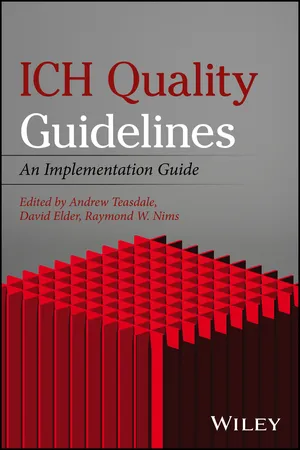
ICH Quality Guidelines
An Implementation Guide
- English
- ePUB (mobile friendly)
- Available on iOS & Android
ICH Quality Guidelines
An Implementation Guide
About this book
Examining the implications and practical implementation of multi-disciplinary International Conference on Harmonization (ICH) topics, this book gives an integrated view of how the guidelines inform drug development strategic planning and decision-making. • Addresses a consistent need for interpretation, training, and implementation examples of ICH guidelines via case studies
• Offers a primary reference point for practitioners addressing the dual challenge of interpretation and practical implementation of ICH guidelines
• Uses case studies to help readers understand and apply ICH guidelines
• Provides valuable insights into guidelines development, with chapters by authors involved in generating or with experience implementing the guidelines
• Includes coverage of stability testing, analytical method validation, impurities, biotechnology drugs and products, and good manufacturing practice (GMP)
Frequently asked questions
- Essential is ideal for learners and professionals who enjoy exploring a wide range of subjects. Access the Essential Library with 800,000+ trusted titles and best-sellers across business, personal growth, and the humanities. Includes unlimited reading time and Standard Read Aloud voice.
- Complete: Perfect for advanced learners and researchers needing full, unrestricted access. Unlock 1.4M+ books across hundreds of subjects, including academic and specialized titles. The Complete Plan also includes advanced features like Premium Read Aloud and Research Assistant.
Please note we cannot support devices running on iOS 13 and Android 7 or earlier. Learn more about using the app.
Information
1
ICHQ1A(R2) Stability Testing of New Drug Substance and Product and ICHQ1C Stability Testing of New Dosage Forms
1.1 Introduction
Table of contents
- Cover
- Title Page
- Table of Contents
- List of Contributors
- An Introduction to ICH Quality Guidelines: Opportunities and Challenges
- 1 ICHQ1A(R2) Stability Testing of New Drug Substance and Product and ICHQ1C Stability Testing of New Dosage Forms
- 2 Stability Testing: Photostability Testing of New Drug Substances and Products ICH Q1B
- 3 ICH Q1D: Bracketing and Matrixing Designs for Stability Testing of New Drug Substances and Products
- 4 ICH Q1E Evaluation for Stability Data
- 5 Q2(R1) Validation of Analytical Procedures: Text and Methodology
- 6 Impurities in New Drug Substances and New Drug Products: ICH Q3A/B: Key Guidelines in the General Impurity Management Process
- 7 ICH Q3C Impurities: Guideline for Residual Solvents
- 8 ICH Q3D Elemental Impurities
- 9 ICH Q4: Pharmacopeial Harmonization and Evaluation and Recommendation of Pharmacopeial Texts for Use in the ICH Regions
- 10 ICH Q5A : Viral Safety of Biotechnology Products
- 11 ICH Q5B Analysis of the Expression Construct in Cell Lines Used for Production of Recombinant DNA‐Derived Protein Products
- 12 ICH Q5C Stability Testing of Biotechnological/Biological Products
- 13 Q5D Derivation and Characterization of Cell Substrates Used for Production of Biotechnological/Biological Products
- 14 Conduct of Risk Assessments: An Integral Part of Compliance with ICH Q5A and ICH Q5D
- 15 ICH Q5E Comparability of Biotechnological/Biological Products Subject to Changes in Their Manufacturing Processes: Summary and Analysis of ICH Q5E Guideline
- 16 ICH Q6A Specifications: Test Procedures and Acceptance Criteria for New Drug Substances and New Drug Products: Chemical Substances
- 17 ICH Q6B Specifications: Test Procedures and Acceptance Criteria for Biotechnological/Biological Products
- 18 Process‐Related Impurities in Biopharmaceuticals: A Deeper Dive into ICH Q6B
- 19 ICH Q7 Good Manufacturing Practice Guide for Active Pharmaceutical Ingredients (APIs)
- 20 Q8(R2): Pharmaceutical Development
- 21 ICH Q9 Quality Risk Management
- 22 ICH Q10 Quality Systems: ICH Q10 Implementation at Genentech/Roche
- 23 ICH Q11: Development and Manufacture of Drug Substance
- 24 ICH M7: Assessment and Control of DNA Reactive (Mutagenic) Impurities in Pharmaceuticals to Limit Potential Carcinogenic Risk
- Index
- End User License Agreement